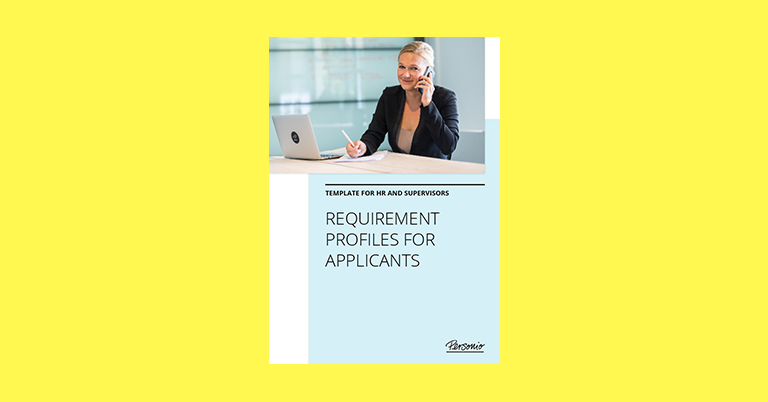A job description typically fulfills two crucial roles: helping the right candidates find their ideal job while helping HR and recruiters vet that candidate to ensure they are the ideal fit for the role. This requires seamless coordination, not only in the description of a role, but the profile, requirements, and responsibilities.
In this article, we will walk you through each to give you a better idea of how to determine role requirements and a job description template that helps ensure your candidate processes are as optimal as possible.
Ready to get started? Download our job profile template right now.
Contents
What Is A Job Description?
What Is A Job Profile?
What Are Job Requirements and Responsibilities?
How Do You Create A Job Profile?
Job Description Template: It Starts With Requirements!
How Do You Write A Great Job Profile?
What’s The Major Benefit Of A Job Profile?
Job Description or Job Profile: Which Do You Need?
What Is A Job Description?
A job description (often referred to as a JD) is a rundown of the main responsibilities, duties, expectations, and benefits of a role within an organization. It is both an opportunity for your organization to stipulate what you require in an applicant’s profile, as well as a skilled applicant’s ability to see what your company offers to them.
You can read our comprehensive guide to job descriptions by clicking here.
What Is A Job Profile?
A job profile is a more straightforward version of a job description. Whereas a job description is partially designed to attract the right candidate, a profile is more the step before that gets you to that point. Think of it like this: a profile would consist of a current employee at your organization sitting down and listing out everything they do on a daily basis.
What Are Job Requirements and Responsibilities?
As we bridge the gap between a job profile and description, we should think of things in terms of requirements and responsibilities. Here’s how it works:
- Requirements – The things a potential employee has that will make them a good fit. Think of an educational background, certifications, or past experiences that make them a fit for a role (perhaps awards or familiarity with certain applications).
- Responsibilities – The things that a potential employee will be tasked with doing. While they may not have specific experience in a company role’s specific responsibilities, their requirements will often tell you a lot of what you need to know in how they can succeed.
Simply put, job requirements put a potential employee in a position to succeed. But, responsibilities are what they will be tasked with when they join your company. One is more foundational, the other is proven through time and likely based on that very same foundation.
How Do You Create A Job Profile?
When it comes to a job description and a job profile, your HR team should already have a picture of which employees are needed across various departments. But, they should also know what current employees and leaders need and want from their future reports and colleagues.
Therefore, HR needs a job profile that lists all the requirements and responsibilities a potential employee needs, so they can ask the questions that help determine if they are a fit (Read More: Our guide to figuring out if employees are a good cultural fit for your organization).
Job Description Template: It Starts With Requirements!
So, your team knows who they want to hire. Or, at the very least, they know the role.
To find the ideal person, you need to put together a requirements profile. This way, your recruiters know who to look for, what kind of questions to ask, and what are the most important qualities a new hire should have.
In short, a requirements profile should include both:
- Hard skills, and
- Soft skills
Let’s start with an example. If you are looking for a programmer, then you should ask for specific programming languages, possibly experience in project management, and how the person works in a team.
If, for example, you have a very international team of developers (as is the case with Personio), then ask about intercultural skills: Is the person open-minded, does he/she speak foreign languages?
How Do You Write A Great Job Profile?
The key is to clarify not only what tasks the candidate would have to perform, but the expectations that leaders in your organization have, too. Do they want someone who is very communicative or are coordination skills more in demand?
If you know these things, HR can ask specific questions about behavior in the initial interview and, in this way, make sure whether there are any overlaps.
The important thing about a job description, and using a job profile during the recruiting process, is to find the right balance between going in-depth and getting the bigger picture.
How Should Leaders Support With Job Profiles?
Leaders don’t always have a catalog of job descriptions in their back pocket. But, even when they do, your business is constantly changing, and so are the job profiles.
That’s why it makes sense for you, as the HR manager, to keep asking various team leads to help revise job descriptions and sharpen job profiles whenever possible.
How Should You Use A Job Description Template?
A job description template, or a requirements template, is all for the sake of efficiency. Not only does it help your recruitment team create job advertisements with ease, but to ask the right questions in the first interview and conversations with a candidate. Once they have this pivotal information, they can get to work with greater effectiveness.
How Does A Job Requirements Template Help?
For a requirements profile, you need information about what the specialist department is looking for. Based on this, you create the profile and can derive specific questions. This helps you to accept or reject the job with good reasoning.
It also helps the specialist. Because nothing is more annoying than going into follow-up interviews with candidates who turn out to be unsuitable. In the end, the responsibility for this will always lie with HR.
What’s The Major Benefit Of A Job Profile?
In some HR departments, each HR manager is responsible for a different job group. One for the technical professions, the second for marketing/sales, etc.
But, what happens if the person in charge is sick and you have to take over the interview? Do you know what questions your colleague will ask the applicant during the telephone interview?
In a worst-case scenario, you may have to step in ad hoc without being prepared. In doing so, you risk not recognizing talent because you have the wrong questions. In addition, you leave an unprofessional impression on the candidate, which can have a negative impact on your brand and lead to a poor candidate experience.
Job Description or Job Profile: Which Do You Need?
A job description and a job profile can fulfill completely different needs, but they can also work together. A job description, on one hand, can help attract the right candidates to apply for roles. A job profile, on the other, can help your HR and recruiting team to narrow down who is exactly the right fit for a role.
How do they do this? By weighing both the hard and soft skills that come from a role’s requirements and responsibilities. When they have a job requirements template in hand, they can ensure that, for each role, they are asking the right questions to find the exact right candidate.
Download Our
Template Today





